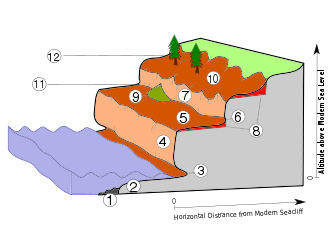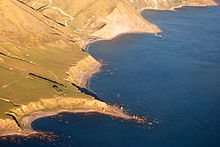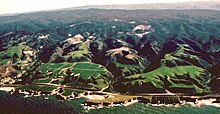Raised beach


A raised beach, coastal terrace,
A raised beach is an emergent coastal landform. Raised beaches and marine terraces are beaches or wave-cut platforms raised above the shoreline by a relative fall in the sea level.[5]

Around the world, a combination of tectonic coastal uplift and
A marine terrace commonly retains a shoreline angle or inner edge, the slope inflection between the marine abrasion platform and the associated paleo sea-cliff. The shoreline angle represents the maximum shoreline of a transgression and therefore a paleo-sea level.
Morphology

The platform of a marine terrace usually has a gradient between 1°–5° depending on the former tidal range with, commonly, a linear to concave profile. The width is quite variable, reaching up to 1,000 metres (3,300 ft), and seems to differ between the northern and southern hemispheres.[9] The cliff faces that delimit the platform can vary in steepness depending on the relative roles of marine and subaerial processes.[10] At the intersection of the former shore (wave-cut/abrasion-) platform and the rising cliff face the platform commonly retains a shoreline angle or inner edge (notch) that indicates the location of the shoreline at the time of maximum sea ingression and therefore a paleo-sea level.[11] Sub-horizontal platforms usually terminate in a low tide cliff, and it is believed that the occurrence of these platforms depends on tidal activity.[10] Marine terraces can extend for several tens of kilometers parallel to the coast.[3]
Older terraces are covered by marine and/or alluvial or colluvial materials while the uppermost terrace levels usually are less well preserved.[12] While marine terraces in areas of relatively rapid uplift rates (> 1 mm/year) can often be correlated to individual interglacial periods or stages, those in areas of slower uplift rates may have a polycyclic origin with stages of returning sea levels following periods of exposure to weathering.[2]
Marine terraces can be covered by a wide variety of
Formation
It is now widely thought that marine terraces are formed during the separated highstands of
Causes

The formation of marine terraces is controlled by changes in environmental conditions and by
Processes of
Processes of isostasy involve the uplift of continental crusts along with their shorelines. Today, the process of glacial isostatic adjustment mainly applies to Pleistocene glaciated areas.[19] In Scandinavia, for instance, the present rate of uplift reaches up to 10 millimetres (0.39 in)/year.[20]
In general, eustatic marine terraces were formed during separate sea level highstands of
Jerky tectonic uplifts can also lead to marked terrace steps while smooth relative sea level changes may not result in obvious terraces, and their formations are often not referred to as marine terraces.[11]
Processes
Marine terraces often result from
It is believed that the terrace gradient increases with tidal range and decreases with rock resistance. In addition, the relationship between terrace width and the strength of the rock is inverse, and higher rates of uplift and subsidence as well as a higher slope of the hinterland increases the number of terraces formed during a certain time.[26]
Furthermore, shore platforms are formed by denudation and marine-built terraces arise from accumulations of materials removed by shore erosion.[2] Thus, a marine terrace can be formed by both erosion and accumulation. However, there is an ongoing debate about the roles of wave erosion and weathering in the formation of shore platforms.[10]
While a terrace sequence can date back hundreds of thousands of years, its degradation is a rather fast process. A deeper transgression of cliffs into the shoreline may completely destroy previous terraces; but older terraces might be decayed[25] or covered by deposits, colluvia or alluvial fans.[3] Erosion and backwearing of slopes caused by incisive streams play another important role in this degradation process.[25]
Land and sea level history
The total displacement of the shoreline relative to the age of the associated interglacial stage allows calculation of a mean uplift rate or the calculation of eustatic level at a particular time if the uplift is known.
In order to estimate vertical uplift, the eustatic position of the considered paleo sea levels relative to the present one must be known as precisely as possible. Current
Sequence can also occur where the accumulation of ice sheets have depressed the land so that when the ice sheets melts the land readjusts with time thus raising the height of the beaches (glacio-isostatic rebound) and in places where co-seismic uplift occur. In the latter case, the terrace are not correlated with sea level highstand even if co-seismic terrace are known only for the Holocene.
Mapping and surveying

For exact interpretations of the morphology, extensive datings, surveying and mapping of marine terraces is applied. This includes
Correlation and dating
Different methods for dating and correlation of marine terraces can be used and combined.
Correlational dating
The morphostratigraphic approach focuses especially in regions of
The
The biostratigraphic approach uses remains of organisms which can indicate the age of a marine terrace. For that, often mollusc shells, foraminifera or pollen are used. Especially Mollusca can show specific properties depending on their depth of sedimentation. Thus, they can be used to estimate former water depths.[24]
Marine terraces are often correlated to
Direct dating
There are various methods for the direct dating of marine terraces and their related materials. The most common method is
In order to calculate the eustatic sea level for each dated terrace, it is assumed that the eustatic sea-level position corresponding to at least one marine terrace is known and that the uplift rate has remained essentially constant in each section.[2]
Relevance for other research areas

Marine terraces play an important role in the research on
Furthermore, with the knowledge of eustatic sea level fluctuations, the speed of isostatic uplift can be estimated[49] and eventually the change of relative sea levels for certain regions can be reconstructed. Thus, marine terraces also provide information for the research on climate change and trends in future sea level changes.[10][50]
When analyzing the morphology of marine terraces, it must be considered, that both
Prominent examples

Raised beaches are found in a wide variety of coast and
Other important sites include various coasts of

Along many coasts of mainland and islands around the
Along the coasts of
Other considerable examples include marine terraces rising up to 360 m (1,180 ft) on some Philippine Islands[58] and along the Mediterranean Coast of North Africa, especially in Tunisia, rising up to 400 m (1,300 ft).[59]
Related coastal geography
Uplift can also be registered through tidal notch sequences. Notches are often portrayed as lying at sea level; however notch types actually form a continuum from wave notches formed in quiet conditions at sea level to surf notches formed in more turbulent conditions and as much as 2 m (6.6 ft) above sea level.[60] As stated above, there was at least one higher sea level during the Holocene, so that some notches may not contain a tectonic component in their formation.
See also
- Similar features
- Beach erosion and accretion
- Beach evolution
- Beach morphodynamics
- Beach nourishment
- Modern recession of beaches
- Paleoshoreline
- Fossil beach
- Coastal management, to prevent coastal erosion and creation of beach
- Coastal and oceanic landforms
- Coastal development hazards
- Coastal erosion
- Coastal geography
- Coastal engineering
- Coastal and Estuarine Research Federation (CERF)
- Erosion
- Longshore drift
- Deposition (sediment)
- Coastal sediment supply
- Sand dune stabilization
- Submersion
References
- ^ a b Pinter, N (2010): 'Coastal Terraces, Sealevel, and Active Tectonics' (educational exercise), from "Archived copy" (PDF). Archived from the original (PDF) on 2010-10-10. Retrieved 2011-04-21.
{{cite web}}: CS1 maint: archived copy as title (link) [02/04/2011] - ^ a b c d e f g Pirazzoli, PA (2005a): 'Marine Terraces', in Schwartz, ML (ed) Encyclopedia of Coastal Science. Springer, Dordrecht, pp. 632–633
- ^ a b c d e Strahler AH; Strahler AN (2005): Physische Geographie. Ulmer, Stuttgart, 686 p.
- ^ Leser, H (ed)(2005): ‚Wörterbuch Allgemeine Geographie. Westermann&Deutscher Taschenbuch Verlag, Braunschweig, 1119 p.
- ^ "The Nat -". www.sdnhm.org.
- ^ Johnson, ME; Libbey, LK (1997). "Global review of Upper Pleistocene (Substage 5e) Rocky Shores: tectonic segregation, substrate variation and biological diversity". Journal of Coastal Research.
- ^ .
- .
- ^ Pethick, J (1984): An Introduction to Coastal Geomorphology. Arnold&Chapman&Hall, New York, 260p.
- ^ a b c d e f Masselink, G; Hughes, MG (2003): Introduction to Coastal Processes & Geomorphology. Arnold&Oxford University Press Inc., London, 354p.
- ^ .
- ^ S2CID 129630764.
- ^ Finkl, CW (2005): 'Coastal Soils' in Schwartz, ML (ed) Encyclopedia of Coastal Science. Springer, Dordrecht, pp. 278–302
- .
- .
- ^ Bull, W.B., 1985. Correlation of flights of global marine terraces. In: Morisawa M. & Hack J. (Editor), 15th Annual Geomorphology Symposium. Hemel Hempstead, State University of New York at Binghamton, pp. 129–152.
- ^ Ota, Y (1986). "Marine terraces as reference surfaces in late Quaternary tectonics studies: examples from the Pacific Rim". Royal Society of New Zealand Bulletin. 24: 357–375.
- .
- ^ a b c d Ahnert, F (1996) – Einführung in die Geomorphologie. Ulmer, Stuttgart, 440 p.
- ^ Lehmkuhl, F; Römer, W (2007): 'Formenbildung durch endogene Prozesse: Neotektonik', in Gebhardt, H; Glaser, R; Radtke, U; Reuber, P (ed) Geographie, Physische Geographie und Humangeographie. Elsevier, München, pp. 316–320
- .
- ^ a b Johnson, ME; Libbey, LK (1997). "Global Review of Upper Pleistocene (Substage 5e) Rocky Shores: Tectonic Segregation, Substrate Variation, and Biological Diversity". Journal of Coastal Research. 13 (2): 297–307.
- .
- ^ a b c d e f g h Worsley, P (1998): 'Altersbestimmung – Küstenterrassen', in Goudie, AS (ed) Geomorphologie, Ein Methodenhandbuch für Studium und Praxis. Springer, Heidelberg, pp. 528–550
- ^ S2CID 19075109.
- .
- doi:10.1130/g22062.1.
- S2CID 59487926.
- S2CID 129024575.
- S2CID 55262041.
- ^ Imbrie, J. et al., 1984. The orbital theory of Pleistocene climate: support from revised chronology of the marine 18O record. In: A. Berger, J. Imbrie, J.D. Hays, G. Kukla and B. Saltzman (Editors), Milankovitch and Climate. Reidel, Dordrecht, pp. 269–305.
- ^ Hearty, P.J.; Kindler, P. (1995). "Sea-Level Highstand Chronology from Stable Carbonate Platforms (Bermuda and the Bahamas)". Journal of Coastal Research. 11 (3): 675–689.
- .
- .
- S2CID 128395986.
- ^ Schellmann, G; Brückner, H (2005): 'Geochronology', in Schwartz, ML (ed) Encyclopedia of Coastal Science. Springer, Dordrecht, pp. 467–472
- ^ .
- .
- ^ Brückner, H (1980): 'Marine Terrassen in Süditalien. Eine quartärmorphologische Studie über das Küstentiefland von Metapont', Düsseldorfer Geographische Schriften, 14, Düsseldorf, Germany: Düsseldorf University
- ^ .
- ^ S2CID 129506275.
- .
- .
- ^ .
- .
- ^ .
- ^ a b c Crozier, MJ; Preston NJ (2010): 'Wellington's Tectonic Landscape: Astride a Plate Boundary' in Migoń, P. (ed) Geomorphological Landscapes of the World. Springer, New York, pp. 341–348
- ^ S2CID 129074978.
- ^ Press, F; Siever, R (2008): Allgemeine Geologie. Spektrum&Springer, Heidelberg, 735 p.
- ^ Schellmann, G; Radtke, U (2007). "Neue Befunde zur Verbreitung und chronostratigraphischen Gliederung holozäner Küstenterrassen an der mittel- und südpatagonischen Atlantikküste (Argentinien) – Zeugnisse holozäner Meeresspiegelveränderungen". Bamberger Geographische Schriften. 22: 1–91.
- .
- ^ Wellman, HW (1969). "Tilted Marine Beach Ridges at Cape Turakirae, N.Z.". Tuatara. 17 (2): 82–86.
- ^ Pirazzoli, PA (2005b.): 'Tectonics and Neotectonics', Schwartz, ML (ed) Encyclopedia of Coastal Science. Springer, Dordrecht, pp. 941–948
- .
- S2CID 36558992.
- .
- ^ UNESCO (2006): Huon Terraces – Stairway to the Past. from https://whc.unesco.org/en/tentativelists/5066/ [13/04/2011]
- ^ Eisma, D (2005): 'Asia, eastern, Coastal Geomorphology', in Schwartz, ML (ed) Encyclopedia of Coastal Science. Springer, Dordrecht, pp. 67–71
- ^ Orme, AR (2005): 'Africa, Coastal Geomorphology', in Schwartz, ML (ed) Encyclopedia of Coastal Science. Springer, Dordrecht, pp. 9–21
- .
External links
- Notes at NAHSTE
- US Geological Survey Marine Terrace Fact Sheet - Wikimedia link, USGS link


